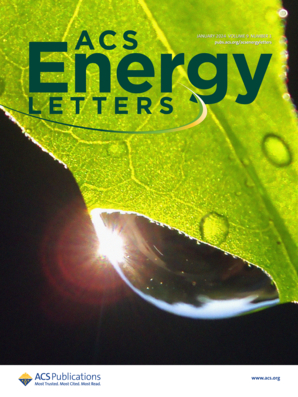碳酸盐/氢氧化物分离提高了CO2吸收率和电化学释放效率
IF 19.3
1区 材料科学
Q1 CHEMISTRY, PHYSICAL
引用次数: 0
摘要
使用氢氧化物溶液的电化学CO2捕获系统面临着严峻的性能权衡,因为快速吸收CO2所必需的氢氧化物离子降低了随后电化学CO2释放的电流效率。在这项工作中,我们提出了二氧化碳吸收和释放之间的碳酸盐/氢氧化物分离步骤,以提供一个集中的碳酸盐流进行有效的电化学释放和一个单独的氢氧化物流进行快速吸收。我们结合二氧化碳吸收、纳滤分离和电化学释放的实验,建立了一个综合模型,说明了系统性能的权衡。我们发现,采用商用纳滤膜进行分离可以在不牺牲吸收率的情况下将电化学电流效率提高多达6倍。在直接空气捕获的情况下,纳滤方法降低了20-30%的成本,并显著提高了系统的操作灵活性。这种碳酸盐/氢氧化物分离也可用于其他系统,如点源捕获和综合CO2捕获和转化为有价值的产品。本文章由计算机程序翻译,如有差异,请以英文原文为准。

Carbonate/Hydroxide Separation Boosts CO2 Absorption Rate and Electrochemical Release Efficiency
Electrochemical CO2 capture systems using hydroxide solutions face stiff performance trade-offs, as the hydroxide ions necessary for rapid CO2 absorption reduce the current efficiency of subsequent electrochemical CO2 release. In this work, we propose a carbonate/hydroxide separation step between CO2 absorption and release to provide a concentrated carbonate stream for efficient electrochemical release and a separate hydroxide stream for rapid absorption. We combine experiments on CO2 absorption, nanofiltration separation, and electrochemical release to build a comprehensive model that illustrates system performance trade-offs. We find that employing commercial nanofiltration membranes for separation increases the electrochemical current efficiency by as much as six-fold without sacrificing absorption rate. In the case of Direct Air Capture, the nanofiltration approach reduces costs by 20-30% and significantly increases the operational flexibility of the system. Such carbonate/hydroxide separations may also find use in other systems such as point source capture and integrated CO2 capture and conversion to valuable products.
求助全文
通过发布文献求助,成功后即可免费获取论文全文。
去求助
来源期刊

ACS Energy Letters
Energy-Renewable Energy, Sustainability and the Environment
CiteScore
31.20
自引率
5.00%
发文量
469
审稿时长
1 months
期刊介绍:
ACS Energy Letters is a monthly journal that publishes papers reporting new scientific advances in energy research. The journal focuses on topics that are of interest to scientists working in the fundamental and applied sciences. Rapid publication is a central criterion for acceptance, and the journal is known for its quick publication times, with an average of 4-6 weeks from submission to web publication in As Soon As Publishable format.
ACS Energy Letters is ranked as the number one journal in the Web of Science Electrochemistry category. It also ranks within the top 10 journals for Physical Chemistry, Energy & Fuels, and Nanoscience & Nanotechnology.
The journal offers several types of articles, including Letters, Energy Express, Perspectives, Reviews, Editorials, Viewpoints and Energy Focus. Additionally, authors have the option to submit videos that summarize or support the information presented in a Perspective or Review article, which can be highlighted on the journal's website. ACS Energy Letters is abstracted and indexed in Chemical Abstracts Service/SciFinder, EBSCO-summon, PubMed, Web of Science, Scopus and Portico.
 求助内容:
求助内容: 应助结果提醒方式:
应助结果提醒方式:


